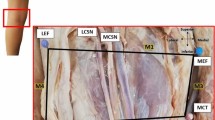Abstract
We aimed to navigate the surgeon regarding the localization of the main anatomical structures at the anterior part of the ankle joint, in order to find easily the safest anatomical points with reference to the superficial peroneal nerve (SPN), in particular for anterolateral portal placement in ankle arthroscopy. Sixty-three ankles in 36 fresh cadavers were dissected. In all specimens we examined (1) the distance between the SPN bifurcation and the most distal point of the lateral malleolus; and at the level of ankle joint, (2) the number of SPN, (3) the distance between the medial and intermediate dorsal cutaneous nerves, which are branches of the SPN, (4) the localization of the peroneus tertius (PT) tendon in relation to the lateral malleolus, (5) the width of the extensor digitorum longus (EDL) tendon, (6) the relationship of the PT tendon and (7) the relationship of the extensor hallucis longus (EHL) tendon with the SPN. The results were as follows: (1) In 41 ankles with bifurcation (65%) the average distance was 71.8±35.3 mm. (2) There were two SPN branches in 39 (62%), three branches in seven (11%) and one branch in 17 (27%) cases. (3) In 39 ankles with two branches of the SPN, the mean distance was 15.2±7.1 mm. (4) The lateral border of the PT tendon was positioned a mean distance of 20.8±3.3 mm proximal and 25.2±5.8 mm medial to the reference points. (5) The mean width was 10.1±2.9 mm. (6) In 42 ankles (67%) the distance between the lateral border of the PT tendon and the SPN was a mean of 6.2±6.6 mm, median of 3 mm (range 0–22 mm lateral to the tendon). (7) In 56 cases (89%) a branch of the SPN was found a mean of 6.6±4 mm and a median of 6 mm lateral to the EHL tendon, and in seven cases (11%) on the tendon. According to our study, in ankle arthroscopy the risk of the SPN injury is maximal in the 0–3 mm lateral to the PT tendon. To avoid injury to the SPN, the safest placement of the anterolateral portal is 4 mm lateral to the PT tendon.











Similar content being viewed by others
References
Adkison DP, Bosse MJ, Gaccione DR, Gabriel KR (1991) Anatomical variations in the course of the superficial peroneal nerve. J Bone Joint Surg Am 73:112–114
Baker CL, Andrews JR, Ryan JB (1986) Arthroscopic treatment of transchondral talar dome fractures. Arthroscopy 2:82–87
Barber FA, Click J, Britt BT (1990) Complications of ankle arthroscopy. Foot Ankle 10:263–266
Buckingham RA, Winson IG, Kelly AJ (1997) An anatomical study of a new portal for ankle arthroscopy. J Bone Joint Surg Br 79:650–652
Burman MS (1931) Arthroscopy or the direct visualisation of joints: an experimental cadaver study. J Bone Joint Surg 13:669–695
Canovas F, Bonnel F, Kouloumdjian P (1996) The superficial peroneal nerve at the foot. Organisation, surgical applications. Surg Radiol Anat 18:241–244
Feiwell LA, Frey C (1993) Anatomic study of arthroscopic portal sites of the ankle. Foot Ankle 14:142–147
Ferkel RD, Dalton DH, Guhl JF (1996) Neurological complications of ankle arthroscopy. Arthroscopy 12:200–208
Guhl JF (1988) New concepts (distraction) in ankle arthroscopy. Arthroscopy 4:160–167
Martin DF, Baker CL, Curl WW, Andrews JR, Robie DB, Haas AF (1989) Operative ankle arthroscopy. Am J Sports Med 17:16–23
Saito A, Kikuchi S (1998) Anatomic relations between ankle arthroscopic portal sites and the superficial peroneal and saphenous nerves. Foot Ankle Int 19:748–752
Sandmeier RH, Renstrom PA (1995) Ankle arthroscopy. Scand J Med Sci Sports 5:64–70
Small NC (1986) Complications in arthroscopy: the knee and other joints. Arthroscopy 4:213–258
Takao M, Uchio Y, Shu N, Ochi M (1998) Anatomic bases of ankle arthroscopy: study of superficial and deep peroneal nerves around anterolateral and anterocentral approach. Surg Radiol Anat 20:317–320
Takao M, Ochi M, Shu N, Uchio Y, Naito K, Tobita M, Matsusaki M, Kawasaki K (2001) A case of superficial peroneal nerve injury during ankle arthroscopy. Arthroscopy 17:403–404
Author information
Authors and Affiliations
Corresponding author
Rights and permissions
About this article
Cite this article
Ögüt, T., Akgün, I., Kesmezacar, H. et al. Navigation for ankle arthroscopy: anatomical study of the anterolateral portal with reference to the superficial peroneal nerve. Surg Radiol Anat 26, 268–274 (2004). https://doi.org/10.1007/s00276-004-0231-5
Received:
Accepted:
Published:
Issue Date:
DOI: https://doi.org/10.1007/s00276-004-0231-5




